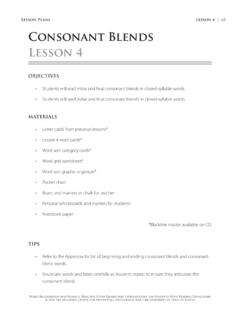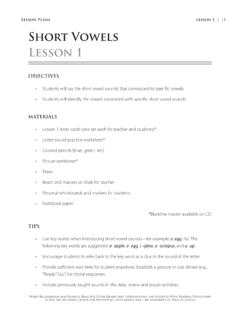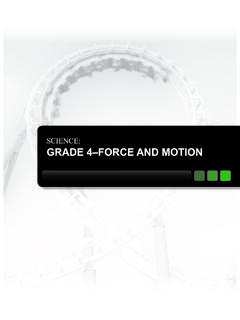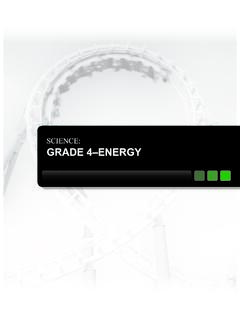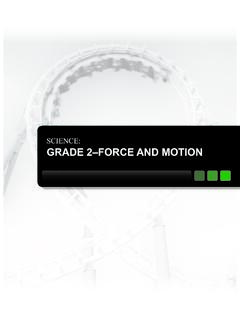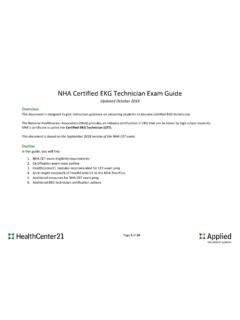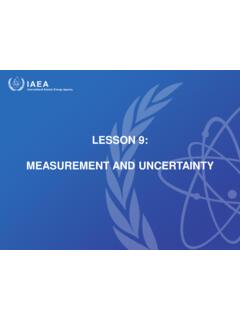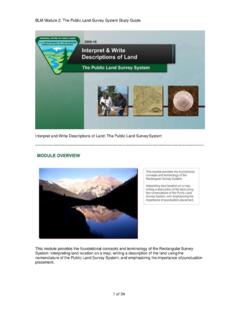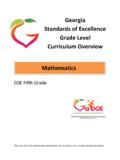Transcription of SCIENCE: GRADE 3–ENERGY
1 SCIENCE: GRADE 3 ENERGY202 GRADE 3 EnergyExploring EnergyTEKS3 (6) Force, motion, and energy. The student knows that forces cause change and that energy exists in many forms. (A) The student is expected to explore different forms of energy, including mechanical, light, sound, and heat/thermal in everyday life. ScienceScience Process Skills3 (2) Scientific investigation and reasoning. The student uses scientific inquiry methods during laboratory and outdoor investigations. (B) The student is expected to collect data by observing and measuring using the metric system and recognize differences between observed and measured data.
2 (F) The student is expected to communicate valid conclusions supported by data in writing, by drawing pictures, and through verbal (4) Scientific investigation and reasoning. The student knows how to use a variety of tools and methods to conduct science inquiry. (A) The student is expected to collect, record, and analyze information using tools, including microscopes, cameras, computers, hand lenses, metric rulers, Celsius thermometers, wind vanes, rain gauges, pan balances, graduated cylinders, beakers, spring scales, hot plates, meter sticks, compasses, magnets, collecting nets, notebooks, sound recorders, and Sun, Earth, and Moon system models; timing devices, including clocks and stopwatches.
3 And materials to support observation of habitats of organisms such as terrariums and ObjectiveI can explore different forms of energy and how we use them. 2012 TEXAS EDUCATION AGENCY. ALL RIGHTS 3 EnergyMathematics3 (11) measurement . The student directly compares the attributes of length, area, weight/mass, and capacity, and uses comparative language to solve problems and answer questions. The student selects and uses standard units to describe length, area, capacity/volume, and weight/mass. (A) The student is expected to use linear measurement tools to estimate and measure lengths using standard (12) measurement .
4 The student reads and writes time and measures temperature in degrees Fahrenheit to solve problems. (A) The student is expected to use a thermometer to measure Language Arts and Reading3 (13) Reading/comprehension of informational text/expository text. Students analyze, make inferences and draw conclusions about expository text and provide evidence from text to support their understanding.(B) Students are expected to draw conclusions from the facts presented in text and support those assertions with textual (22) Oral and written conventions/conventions. Students understand the function of and use the conventions of academic language when speaking and writing.
5 Students continue to apply earlier standards with greater complexity.(B) Students are expected to use the complete subject and the complete predicate in a sentence.(C) Students are expected to use complete simple and compound sentences with correct subject-verb (29) Listening and speaking/listening. Students use comprehension skills to listen attentively to others in formal and informal settings. Students continue to apply earlier standards with greater complexity. (A) Students are expected to listen attentively to speakers, ask relevant questions, and make pertinent 3 Energy3 (30) Listening and speaking/speaking.
6 Students speak clearly and to the point, using the conventions of language. Students continue to apply earlier standards with greater complexity. Students are expected to speak coherently about the topic under discussion, employing eye contact, speaking rate, volume, enunciation, and the conventions of language to communicate ideas (31) Listening and speaking/teamwork. Students work productively with others in teams. Students continue to apply earlier standards with greater complexity. Students are expected to participate in teacher- and student-led discussions by posing and answering questions with appropriate detail and by providing suggestions that build upon the ideas of 19.
7 Reading/comprehension skills. Students use a flexible range of metacognitive reading skills in both assigned and independent reading to understand an author s message. Students will continue to apply earlier standards with greater depth in increasingly more complex texts as they become self-directed, critical readers. (C) The student is expected to monitor and adjust comprehension ( , using background knowledge, creating sensory images, re-reading a portion aloud, generating questions).(D) The student is expected to make inferences about text and use textual evidence to support understanding.
8 2012 TEXAS EDUCATION AGENCY. ALL RIGHTS 3 EnergyEnglish Language Proficiency Standards3 (D) Cross-curricular second language acquisition/speaking. The student is expected to speak using GRADE -level content area vocabulary in context to internalize new English words and build academic language (G) Cross-curricular second language acquisition/reading. The student is expected to demonstrate comprehension of increasingly complex English by participating in shared reading, retelling or summarizing material, responding to questions, and taking notes commensurate with content area and GRADE level to Intervention/Tier 1 DifferentiationAll science lessons support students in receiving quality Tier 1 instruction.
9 Using the 5E model, knowledge is taught in a variety of contexts, integrating math, science, and ELA content, thus supporting the active engagement of students with the content. Lesson-specific differentiation strategies for addressing diverse student needs can be found throughout each lesson in sections titled Differentiation Strategy. Differentiation should focus on skills students did not understand and extend the lesson for advanced students; be conducted in small groups or embedded in whole-group instruction; and provide students with a variety of strategies to process the information, such as -allowing for additional opportunities for verbal brainstorming of words associated with a topic (with teacher taking dictation); -making clear connections of new and more complex concepts to foundational aspects and prior knowledge.
10 -participating in more tangible experiences, such as experiments, investigations, and active exploration; -sorting academic vocabulary words into categories by common attributes process words or science content vocabulary;Language ObjectiveI can show that I understand English text about different forms of 3 Energy -organizing brainstorming into semantic maps or creating graphic organizers; -discussing the meaning of a graphic organizer with a partner; and -creating a visual representation to demonstrate the handout in the Content Resources section that addresses instructional and Career Readiness Collaborative and safe working practices.

